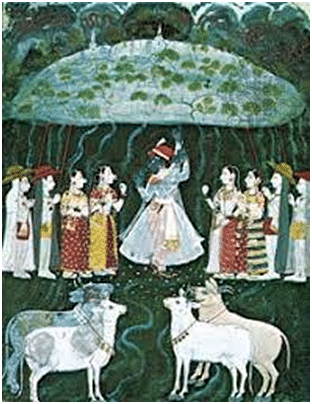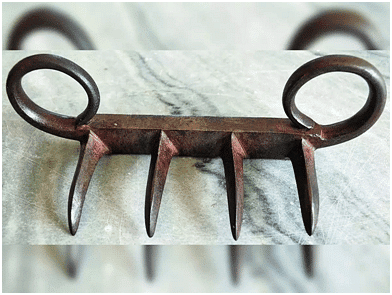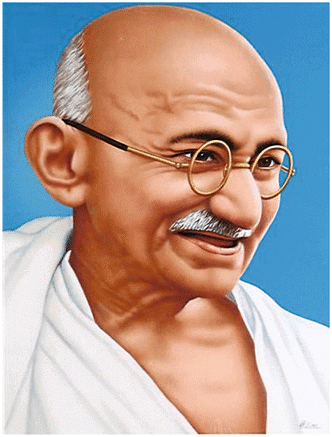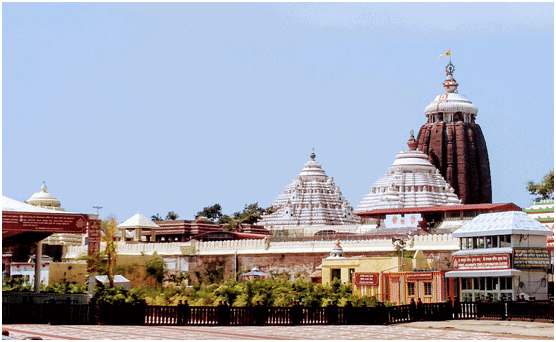History, Art & Culture: October 2023 UPSC Current Affairs | Current Affairs & Hindu Analysis: Daily, Weekly & Monthly PDF Download
Shri Ramalinga Swamy
Who Was Ramalinga Swamy?
Other Names
Ramalinga Swamy is also revered as Vallalar.
Identity
He is celebrated as a Tamil saint, known for his profound spiritual teachings and humanitarian efforts.
Why is Ramalinga Swamy Significant?
Contributions to Society
Ideas
- Samarasa Suddha Sanmarga Sathiya Sangam
- Meaning: Society for pure truth in universal self-hood.
- Goal: To eliminate the caste system and promote equality among all individuals.
Principles
- Compassion: At the core of Ramalinga Swamy’s teachings was the principle of compassion, emphasizing empathy and kindness towards all living beings.
- Non-Violence: He introduced the concept of “Jeeva Karunyam,” advocating non-violence and reverence for all life forms.
- Worship Style: Ramalinga Swamy promoted a unique style of worship, where the divine was perceived as light, and worship was primarily mental, without the use of traditional puja apparatus.
Establishments
- Sathya Dharma Salai
- Year: Established in 1867.
- Location: Vadalur.
- Purpose: This institution provided free food for the poor, embodying the principle of selfless service.
- Sathya Gnana Sabhai
- Year: Founded in 1872.
- This organization aimed to propagate spiritual knowledge and foster a sense of unity among people.
Literary Works
Ramalinga Swamy’s literary contributions include: copyright©iasexpress.net
- Thiruvarutpa
- Type: A compilation of poems that encapsulate his spiritual insights and experiences.
- Manumurai Kanda Vāsagam
- Jeeva Karunya Ozhukkam
When Did Ramalinga Swamy Live?
Era
Ramalinga Swamy lived during the 19th century, a time when his ideas and actions challenged societal norms and inspired positive change.
Allah Baksh and Mewari Style Painting
Why in News?
Allah Baksh, a Mewari miniature painter late 17th century, portrayed the Interpretation of Mahabharata in his Painting and is known for his intricate and delightful representation.
Who was Allah Baksh?
About:
Allah Baksh was a court painter employed by Maharaja Jai Singh of Udaipur during the late 17th century.
Paintings and Portrayal:
- Each painting by Allah Baksh meticulously portrays the details of characters' costumes, the flora and fauna in the background, and the depiction of magical and mystical events.
- These miniatures encapsulate a delightful representation of the Mahabharata, showcasing a dialogue between the verbal and visual imaginations of the poet and the painter.

What is Mewari Style Miniature Painting?
- About:
- Mewār painting, one of the most important schools of Indian miniature painting of the 17th and 18th Centuries. It is a school in the Rājasthanī style and was developed in the Hindu principality of Mewār (in Rājasthān state).
- It is a highly refined and intricate form of painting characterized by its attention to detail, vibrant colors, and meticulous craftsmanship.
- The works of the school are characterized by simple bright color and direct emotional appeal.
- The comparatively large number of paintings to which dates and places of origin can be ascribed make possible a more comprehensive picture of the development of painting in Mewār than in any other Rājasthanī school.
- Famous Painter: Sahibdin (painted the Ragamala in 1628).

What is Miniature Painting?
- About:
- Miniature paintings are colorful handmade paintings very small in size. One of the outstanding features of these paintings is the intricate brushwork which contributes to their unique identity.
- The colors used in the paintings are derived from various natural sources like vegetables, indigo, precious stones, gold and silver.
- They were often painted for either books or albums, on perishable material including paper, palm leaves and cloth.
- The Palas of Bengal are considered the pioneers of miniature painting in India.
- The tradition of miniature paintings was further taken forward by the artists of various Rajasthani schools of painting, including the Kishangarh, Bundi Jaipur, Mewar and Marwar.
- Schools of Miniature Painting:
- Pala School: The earliest Indian miniature paintings are related to the Pala School dating back to the 8th century A.D.
- This school of painting emphasized on the symbolic use of colors and the themes were often taken from the Buddhist tantric rituals.
- Jain School: The Jain School of painting gained prominence in the 11th century A.D when religious texts like ‘Kalpa Sutra’ and ‘Kalkacharya Katha’ were portrayed in the form of miniature paintings.
- Mughal School: The amalgamation of Indian paintings and Persian miniature paintings gave rise to the Mughal School of miniature painting.
- Interestingly, Persian miniature paintings were largely influenced by Chinese paintings.
- Rajasthani School: The decline of the Mughal miniature paintings resulted in the rise of the Rajasthani School. Rajasthani School of painting can be further divided into various schools depending on the region they were created in.
- The Mewar School, Marwar School, Hadoti School, Dhundar School, Kangra and Kullu Schools of art are all part of Rajasthani School of painting.
- Pahari School: Pahari School of miniature painting emerged in the 17th century A.D. These paintings originated in the kingdoms of North India, in the Himalayan region.
- Deccan School: The Deccan School of miniature painting flourished in places like Ahmednagar, Golconda, Tanjore, Hyderabad and Bijapur from 16th to 19th century A.D.
- The Deccan School of miniature painting was largely influenced by the rich traditions of the Deccan and the religious beliefs of Turkey, Persia and Iran.
- Pala School: The earliest Indian miniature paintings are related to the Pala School dating back to the 8th century A.D.
Toto Language
Context
A dictionary titled “Toto Shabda Sangraha” is set to be released with the aim of preserving the Toto language, which is spoken by a mere 1,600 people in parts of West Bengal bordering Bhutan.
About Toto Language
- The Toto language, a Sino-Tibetan language, is primarily spoken orally and is currently written in the Bengali script.
- While a script for Toto was developed in 2015 by Dhaniram Toto, a prominent community member, most Toto speakers still use the Bengali script or write in Bengali.
The trilingual dictionary will translate Toto words into Bengali and English, making it accessible to a wider audience, as the Toto script is still in its early stages of development, and the tribe is more familiar with the Bengali script.
Chhatrapati Shivaji Maharaj’s Wagh Nakh
Why in News?
Maharashtra’s Cultural Affairs Ministry has signed a memorandum of understanding (MoU) with the Victoria and Albert Museum in London to bring back Chhatrapati Shivaji Maharaj’s legendary “Wagh Nakh” a formidable medieval weapon to the state.
- The MoU states that the antique weapon will be handed over to the Government of Maharashtra on a loan basis for a period of three years, during which it will be displayed in museums across the state.
What is the 'Wagh Nakh'?
- The 'wagh nakh,' literally translating to 'tiger claws,' is a unique medieval dagger used across the Indian subcontinent.
- This fearsome weapon featured four or five curved blades affixed to a glove or a bar, designed for personal defence or stealth attacks.
- Its sharp blades were capable of slicing through skin and flesh with ease.
- Chhatrapati Shivaji's Defense with the 'Wagh Nakh':
- Chhatrapati Shivaji faced Afzal Khan, a Bijapur general assigned to stop Shivaji's strong campaigns in the Konkan. Khan suggested a peaceful meeting, but Shivaji, anticipating danger, came prepared.
- He concealed a 'wagh nakh' and wore chainmail (armour made from small metal rings) under his attire. When Khan attacked, Shivaji's 'wagh nakh' struck, resulting in Khan's death, ultimately securing Shivaji's victory.

What are the Key Points Related to Chhatrapati Shivaji Maharaj?
- Birth:
- Born on 19th February 1630, at Shivneri Fort in Pune District, Maharashtra, he was the son of Shahaji Bhonsle, a Maratha general with jagirs in Pune and Supe under the Bijapur Sultanate, and Jijabai, a deeply religious woman who greatly influenced him.
- Important Battles:
Battle of Pratapgad, 1659 | Fought at the fort of Pratapgad near the town of Satara, Maharashtra, between the forces of the Maratha king Chhatrapati Shivaji Maharaj and the Adilshahi general Afzal Khan. |
Battle of Pavan Khind, 1660 | Fought at a mountain pass in the vicinity of fort Vishalgad, near the city of Kolhapur, Maharashtra, between the Maratha Sardar Baji Prabhu Deshpande and Siddi Masud of Adilshahi. |
Sacking of Surat, 1664 | Fought near the city of Surat, Gujarat, between Chhatrapati Shivaji Maharaj and Inayat Khan, a Mughal captain. |
Battle of Purandar, 1665 | Fought between the Mughal Empire and the Maratha Empire. |
Battle of Sinhagad, 1670 | Fought on the fort of Sinhagad near the city of Pune, Maharashtra between Tanaji Malusare, a commander of Maratha ruler Shivaji Maharaj and Udaybhan Rathod, fortkeeper under Jai Singh I who was a Mughal Army Chief. |
Battle of Kalyan, 1682-83 | Bahadur Khan of the Mughal Empire defeated the Maratha army and took over Kalyan. |
Battle of Sangamner, 1679 | Fought between the Mughal Empire and Maratha Empire. This was the last battle in which the Maratha King Shivaji fought. |
- Titles:
- He took on the titles of Chhatrapati, Shakakarta, Kshatriya Kulavantas and Haindava Dharmodhhaarak.
Administration under Shivaji
- Central Administration:
- He established a centralised administration with a council of eight ministers (Ashtapradhan) who were directly responsible to him and advised him on various matters of the state.
- The Peshwa, also known as the Mukhya Pradhan, originally headed the advisory council of Raja Shivaji.
- Provincial administration:
- Shivaji divided his kingdom into four provinces. Each province was further divided into districts and villages. The village was the basic unit of administration and was governed by a Deshpande or Patel with the help of a village panchayat.
- Like the centre, there was a committee or council of eight ministers with Sar-i- ‘Karkun’ or the ‘prantpati’ (Head of the province).
- Revenue Administration:
- Shivaji abolished the Jagirdari System and replaced it with the Ryotwari System, and made changes in the position of hereditary revenue officials which were popularly known as Deshmukhs, Deshpande, Patils , and Kulkarnis.
- Shivaji strictly supervised the Mirasdars who had hereditary rights in land.
- The revenue system was patterned on the Kathi system of Malik Amber in which every piece of land was measured by Rod or Kathi.
- Chauth and Sardeshmukhi were other sources of income.
- Chauth amounted to 1/4th of the standard that was paid to Marathas as a safeguard against Shivaji’s forces raiding non-Maratha territories.
- Sardeshmukhi was an additional levy of 10% demanded from areas outside of the kingdom.
- Military Administration:
- Shivaji established an efficient army, paying ordinary soldiers in cash and high-ranking officials through jagir grants(Saranjam).
- His military included infantry (Mavali foot soldiers), cavalry (horse riders and equipment handlers), and a navy.
- Key roles included the Sar-i-Naubat (Senapati) in charge of the army, Qiladars overseeing forts, Nayaks leading infantry units, Havaldars heading groups of five Nayaks, and Jumladars overseeing five Nayaks.
- Death:
- Shivaji passed away in Raigad in 1680 and was cremated at the Raigad Fort. Shivaji Maharaj Jayanti is celebrated each year on 19th February to remember and praise his courage, warfare tactics and administrative skills.
Mahatma Gandhi’s 154th Birth Anniversary

Why in News?
On 2nd October,2023, Mahatma Gandhi’s 154th birth anniversary was celebrated across the nation to commemorate his principles and ideals that inspire the nation until the present times, owing to the indispensable role played by him during the freedom struggle.
- His contributions to the freedom struggle earned him the epithet of “Father of Nation” which led to his portrait being featured on Indian legal banknotes.
- Being a multi-faceted personality, Mahatma Gandhi had deep interest in music, and he always promoted safeguarding the environment.
Who was Mahatma Gandhi?
Mahatma Gandhi, born Mohandas Karamchand Gandhi on October 2, 1869, in Porbandar, India, was a prominent leader in the Indian independence movement against British rule. He is widely known for his philosophy of nonviolent resistance, which he called "Satyagraha." The term "Mahatma" means "great soul" in Sanskrit and was used to honor his role in India's struggle for independence.
- Gandhi studied law in England and later worked as a lawyer in South Africa, where he became involved in civil rights issues. It was during this time that he developed his principles of nonviolence and civil disobedience as effective means of protest.
- Upon returning to India, Gandhi became a key figure in the Indian National Congress and led various campaigns for civil rights, social reforms, and ultimately, independence from British rule. He played a crucial role in organizing peaceful protests, boycotts, and acts of civil disobedience, such as the famous Salt March in 1930, which aimed to challenge the British monopoly on salt and galvanized public support.
- Gandhi's philosophy and leadership were instrumental in India gaining independence in 1947. However, his vision for a united, nonviolent India was challenged by the religious and communal tensions that arose during the partition of India into two separate nations, India and Pakistan.
- Tragically, Mahatma Gandhi was assassinated on January 30, 1948, by Nathuram Godse, a Hindu nationalist who opposed Gandhi's conciliatory stance toward Muslims. Despite his death, Gandhi's legacy lives on as a symbol of nonviolent resistance and the struggle for justice and human rights.
How did Mahatma Gandhi Become a Permanent Feature on Legal Banknotes of India?
- The Origins of Gandhi’s Image on Indian currency:
- The portrait of Gandhi visible on banknotes is a cut-out of a photograph taken in 1946, where he is standing with British politician Lord Frederick William Pethick-Lawrence.
- The photograph was selected as it had the most suitable expression of Gandhi smiling — the portrait is a mirror image of the cut-out.
- According to Section 25 of the RBI Act, 1934, “the design, form and material of banknotes” shall be such as may be approved by the central government after consideration of the recommendations made by the central board.
- Gandhi’s First Appearance on INR notes:
- Gandhi first featured on Indian currency in 1969, when a special series was issued to commemorate his 100th birth anniversary.
- Then, in October 1987, a series of Rs 500 currency notes, featuring Gandhi, was launched.
- Gandhiji, a Permanent Feature on Banknotes:
- Gandhi was chosen because of his national appeal, and in 1996, a new ‘Mahatma Gandhi Series’ was launched by the RBI to replace the former Ashoka Pillar bank notes.
- Several security features were also introduced, including a windowed security thread, latent image and intaglio features for the visually impaired.
What are Mahatma Gandhi’s Lessons on Sustainability?
- Simplicity and Minimalism:
- Gandhi advocated for a simple and minimalist lifestyle. He believed that individuals should live with the bare minimum and avoid excessive consumption.
- This idea of simple living, or "Sarvodaya," promotes the conservation of resources and a reduced ecological footprint.
- Self-Sufficiency:
- Gandhi emphasized the importance of self-sufficiency at the community level. He promoted the idea of villages being self-reliant in terms of food, clothing, and other basic needs.
- This approach reduces dependence on external resources and minimizes environmental impacts associated with long-distance transportation and trade.
- Nonviolence (Ahimsa):
- Gandhi's principle of nonviolence extends beyond human relations to encompass all living beings and the environment. He believed in the ethical treatment of animals and was a vegetarian himself.
- This reflects his concern for the well-being of all creatures and the importance of coexisting harmoniously with nature.
- Sustainable Agriculture:
- Gandhi supported sustainable and organic farming practices. He advocated for the use of natural fertilizers, crop rotation, and traditional farming methods that preserve soil fertility and reduce the need for chemical inputs.
- Conservation of Resources:
- Gandhi emphasized the responsible use and conservation of natural resources, such as water and forests.
- He believed in protecting and regenerating the environment to ensure that future generations have access to these resources.
- Localism and Decentralization:
- Gandhi was a proponent of decentralization of power and resources. He believed in devolving authority to local communities, which can be more attuned to their own environmental and sustainability needs.
- Swadeshi:
- Gandhi promoted the Swadeshi movement, which encouraged the use of locally produced goods and materials.
- This concept aimed to reduce the ecological impact of long-distance trade and promote local economies.
- Respect for Nature:
- Gandhi believed that humans should have a deep respect and reverence for nature.
- He saw nature as an essential part of human life and called for responsible stewardship of the environment.
- Vasudhaiva Kutumbakam:
- His belief in Vasudev Kutumbakam (the entire world is one family) encourages us to believe that we all are citizens of one world, and that we must remain conscious of global issues.
What is the Relationship of Mahatma Gandhi’s Idea of Politics with Music?
- Bhajans and Religious Music:
- Gandhi had a strong spiritual side, and he often used devotional music, such as bhajans (Hindu religious songs), as a means of connecting with his inner self and finding solace.
- He believed that singing hymns and religious songs helped purify the mind and strengthen one's connection with the divine.
- Inspirational Songs:
- Gandhi encouraged the use of inspirational songs and patriotic songs to unite people in the struggle for independence.
- Songs like "Raghupati Raghava Raja Ram" and "Vaishnav Jan To" were among his favorites and were frequently sung during his prayer meetings and public gatherings.
- Fasting and Silence:
- Gandhi sometimes observed periods of fasting and silence as a form of protest or self-purification.
- During these times, he often communicated with others through written messages and used music to convey his thoughts and feelings.
- Community Bonding:
- Music played a crucial role in bringing communities together during Gandhi's nonviolent movements.
- Chants, songs, and music created a sense of unity and solidarity among the participants in various campaigns, such as the Salt March.
- Promotion of Folk Music:
- Gandhi was a proponent of traditional Indian culture and believed in the preservation of folk music and arts.
- He encouraged the use of local languages and music to connect with the masses, as he believed that they were more relatable and accessible.
- Role in Nonviolent Resistance:
- Music was an integral part of the nonviolent resistance movements led by Gandhi. It served as a means of inspiring and mobilizing people, fostering a sense of collective identity, and uplifting spirits during challenging times.
- Advocacy for Simplicity:
- Gandhi's philosophy of simplicity and minimalism extended to music. He preferred simple and melodious tunes that could be easily understood and appreciated by the common people.
Puri Jagannath Temple’s Ratna Bhandar

Why in News?
Recently, the demand to open the Ratna Bhandar (treasure room) of the Jagannath Temple is growing louder again. The treasure room at the temple has not been unlocked for three decades.
What is Jagannath Temple’s Ratna Bhandar?
- About:
- The precious ornaments of sibling deities, Lord Jagannath, Lord Balabhadra and Goddess Subhadra, given by devotees and erstwhile kings over centuries, are stored in the Ratna Bhandar of the 12th century shrine.
- The Ratna Bhandar consists of two chambers: the Bhitar Bhandar (inner chamber) and the Bahara Bhandar (outer chamber).
- While the outer chamber is opened regularly to fetch ornaments for the deities during important rituals and festivals, the inner chamber has not been opened in the past 38 years.
- Demands for Opening the Ratna Bhandar:
- The demand to open the Ratna Bhandar has gained momentum due to concerns over the chamber's structural integrity.
- The Archaeological Survey of India (ASI), the custodian of the temple, requisitioned the chamber for repair and conservation due to apprehensions of cracks in its walls, which could endanger the priceless ornaments stored within.
Odhuvars in Tamil Nadu
The Government of Tamil Nadu appointed 15 ‘odhuvars’ to government-controlled Hindu temples, including five women odhuvars, a “milestone in the journey for equality.”
Who are Odhuvars?
Odhuvars sing devotional hymns in Tamil Nadu’s Hindu temples but are not priests. They are in the service of Lord Shiva by singing his praise from Thirumurai in Saivite temples. They sing devotional hymns but do not enter the sanctum sanctorum.
Another progressive decision by the Tamil Nadu Government: The recent appointment of three women priests in the state’s temples.
Usage: The example can be used in Qn related to Indian Society/ Women/ Reforms in Religion etc.
About Thirumurai
Tirumurai is a twelve-volume compendium of songs or hymns in praise of Shiva in the Tamil language from the 6th to the 11th century CE by various poets (Nayanars) in Tamil Nadu.
The twelve books are:
|
63 videos|5408 docs|1146 tests
|
FAQs on History, Art & Culture: October 2023 UPSC Current Affairs - Current Affairs & Hindu Analysis: Daily, Weekly & Monthly
| 1. Who was Shri Ramalinga Swamy? |  |
| 2. What is Mewari Style Painting and its connection to Allah Baksh? |  |
| 3. What is Toto Language and where is it spoken? |  |
| 4. What is Chhatrapati Shivaji Maharaj’s Wagh Nakh? |  |
| 5. How is the Ratna Bhandar of Puri Jagannath Temple significant? |  |
















